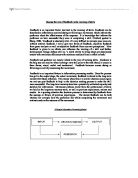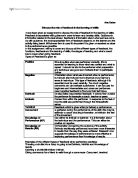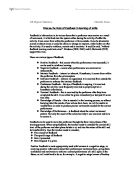Discuss the role of feedback in the learning of skills
Discuss the role of feedback in the learning of skills Feedback is an important factor involved in the learning of skills. Feedback can be described as information received during or following a movement, which informs the performer about the effectiveness of the response. It is knowledge that informs the performer on how successful they were at completing a skill. Crisfield quoted in Sharp, 1986, 'Feedback is absolutely vital. It's very difficult to evaluate your own role without external feedback. I try to give two forms of feedback, objective feedback from game analysis as well as subjective feedback from my own perceptions'. How feedback is given to an athlete can influence the learning of a skill and further development. Knapp defines skill as 'a learnt ability to bring about pre-determined results with maximum efficiency with minimum outlay of time or effort or both.' Feedback and guidance are closely linked in the role of learning skills. Guidance is the help you can receive when learning a new skill prior to the task ahead, it occurs in three forms; visual, verbal and mechanical. Feedback however occurs during or following an activity concerning the movement. Feedback is an important feature in information processing models. Once the process has got to the output stage, the actual movement, feedback is stored in the long-term memory for future reference. This
'Discuss the role of feedback in the learning of skills'.
'Discuss the role of feedback in the learning of skills' According to 'The A-Z of physical education' by James et al 2000, feedback is the information received by the individual or group either during or after completion of the performance. There are many different types of feedback. These are: Intrinsic (inherent) feedback - This comes from within the performer and is in response to the feel of how the skill was performed through the kinaesthetic sense. Extrinsic (augmented) feedback - This type of feedback comes from outside the performer and can be from the coach, teacher, teammates or spectators. Continuous feedback - This is received during the activity and can come from the performers themselves or the coach. Terminal feedback - This is received after the activity and can be given immediately by the coach or some time later, for example when analysing a video of the performance. Knowledge of performance - This type of feedback can be both intrinsic and extrinsic and is information about the technique and performance. For example, a coach will talk to the team after a match about how they played. The feedback can be positive or negative. Knowledge of results - This is generally extrinsic and is information concerning the outcome of the activity, for example, receiving a time in athletics or receiving a score from the judges in gymnastics. Feedback has a variety
Discuss the role of feedback in the learning of skills
Alex Baker Discuss the role of feedback in the learning of skills I have been given an assignment to discuss the role of feedback in the learning of skills. Feedback is associated with guidance in order to learn and develop skills. Guidance is information related to the task ahead, feedback is information about what we have done. As with guidance, the most appropriate form of feedback depends on the learner and the activity being learnt. Whichever form is used it's important it is given or received as close to the performance as possible. In this assignment I will try to cover and discuss all the different types of feedback, the functions, feedback and the learning of skills, the stages of learning and what a coach has to cover when giving feedback. Types of Feedback is given as: Positive Should outline what was performed correctly, this is essential for learning to know what was correct and what to repeat. It should be told to the performer what preparation and technique was good and motivate them to participate further Negative Information about what was incorrect about a performance, but should also include how to improve or put right any errors in technique. This type of feedback, although it is essential must be used carefully. Too much negative comments can de-motivate a performer. It can be used for beginners and intermediates and advanced performers need
Discuss the role of feedback in the learning of skills.
Discuss the role of feedback in the learning of skills 'Feedback is sensory information that results from movement' (Davis et al-2000) Guidance and feedback are extremely helpful when learning new skills. Guidance is information about what you are about to do. It should let the performer know which is the best way to succeed. Feedback is comments about what you have just done. Feedback is most effective given straight after the performance, when what you have done is fresh in your mind. It should be accurate, clear, and easy to understand, in order to aid the learning of skills. Feedback comes in several forms. These are used in conjunction with the learner's ability, and the type of activity being learnt. * Intrinsic * Extrinsic * Positive * Negative * Terminal * Concurrent * Knowledge of performance (KP) * Knowledge of results (KR) Feed back has four main functions; To inform the performer about how well they have done, positive or negative reinforcement, motivation, and punishment. (Galligan et al. 2000) Intrinsic feedback comes from the performer. It is usually focused on the outcomes, and how well the performer has done. It develops kinaesthetic awareness. It can be used as reinforcement. For example, a discus thrower may have thought that the throw felt good, but will not know if it was good enough until they found out the distance thrown.
Discuss the role of feedback in the learning of skills
Discuss the role of feedback in the learning of skills Introduction Feedback (FB) is the final part of the information processing system, which received during or following a movement, to notify the performer about the effectiveness of the response. In order to learn and develop skills, feedback and guidance are necessary. It also required knowledge of result and knowledge of performance. Knowledge of performance (KP) and Knowledge of results (KR) KR is the knowing what the result of our action have been, which is generally extrinsic and given verbally. We modify them to produce precise movement needed for the correct performance of a skill. For example, in the rugby game, a coach may say you pass the ball so wide, and he may add some additional extrinsic feedback to tell why your action is incorrect and how to improve it. This type of feedback is called 'knowledge of performance', which arises from the movement/ performer itself. After a game, a coach will tell to his team about the way they played. Type of the feedback Feedback gives information about the quality of a movement/performance. We should know each type of feedback has its effect on skill improvement and value related to learning stages: Intrinsic feedback Intrinsic feedback sometimes referred to as internal feedback. All this information is inherent to the task. You can feel the response of how the
Marketing Media and Audience Feedback
OCR LEVEL 3 NATIONALS IN MEDIA UNIT 4: MARKETING MEDIA AND AUDIENCE FEEDBACK Candidate Name: Dean J Hill Candidate Number: 9207 Centre Name: Manor Foundation College Centre Number: 20663 Assignment Tutor: Mr Derek Coen Date of Submission: 14th December 2006 Submission Point: Media Department INTRODUCTION INTRODUCTION The fundamental aspects of marketing media and audience feedback, in terms of their essential key concepts, promotional content and promotional media, are significant to the large proportion of media industries and organisations engaged in this important resourceful activity. It consists of the social and managerial processes by which products, services and value are exchanged in order to fulfil needs and wants, primarily achieved through a process which includes, but is not limited to, the stimulating and dynamic mediums of advertising and promotion where the feedback of various audiences is crucial to the state of media performance and proficiency.1 For this unit of work, an understanding of the different aspects of marketing and how it is completed professionally will be defined, established and consequently developed to increase my level of knowledge regarding the numerous methods of investigating research by media producers and official research bodies. A similar approach to audience feedback will be conducted to progress towards a
Discuss the role of feedback in the learning of skills
Discuss the role of feedback in the learning of skills Feedback is essential for the learning and development of skills. Errors should be spotted at early stages of an athletes learning process, to prevent permanent 'bad habits'. It motivates athletes and helps promote learning by developing a link between stimulus and response. It creates a simple schema for cognitive phase athletes and improves a more complex schema for autonomous phase performers. Feedback is linked with guidance; generally from a coach, teacher or senior athlete to help improve and correct skills. However feedback's used to improve mistakes post-performance, guidance's issued before to prevent mistakes. It should be clear, concise and relevant. There are 8 types, some suited to particular athletes. Intrinsic Feedback (kinaesthetic) comes from the athlete. They know whether the skill was performed and executed correctly (the nervous system-proprioceptors in the muscles) it's the immediate response felt, so experienced athletes have higher quality and understanding of the bodies' senses. This comes from experience. Thus beginners don't benefit as they're still learning the skills. E.g. Beckham automatically knows if he struck the ball correctly to gain height, whereas beginners may not recognise the technique needs to alter in order to gain more. This skill is psychomotor (developed through intrinsic) as
Discuss the role of Feedback in the learning of skills.
Discuss the role of Feedback in the learning of skills. When we play sport we are given many different types of feedback by different people and they come in different forms. Intrinsic feedback refers to information that is inherent in a task. In tennis, for example, the lines on the court provide information as to whether a shot was good. The net and markings of the service area provide information as to the efficacy of a serve. The primary role of intrinsic feedback is that it allows the performer to evaluate a response. It provides a frame of reference so that errors in response can be detected and attempts made to correct them. It is this error between the actual response and the desired response that acts as input for the next response, and it is in this sense that theorists talk about feedback loops. It is obvious that some sports activities provide a great deal of intrinsic evaluative feedback. This is true of tennis, bowling for example. Others such as track running events very little. Although kinesthetic feedback is an important variable in most motor learning theories it is difficult for the teacher or coach to use. It is potentially available through manual manipulation of the performer by the teacher. When the limbs and bodily positions of a performer can be manipulated by the teacher, some form of kinesthetic feedback is produced. The idea, quite simply, is
Discuss the role of feedback in the learning of skills
Discuss the role of feedback in the learning of skills The essay is to discuss the role of feedback in the learning of skills. Galligan et al say "whichever form is used, it is important that it is given or received as close to the performance as possible. It must be accurate, understandable, concise and constructive." Feedback can be positive, negative, extrinsic, intrinsic, terminal, concurrent, the knowledge of performance and the knowledge of results. All these types of feedback is the receiving and giving of sensory information concerning both positive and negative outcomes of a performance. First before giving out feedback the coach must assess the learner's current ability and what phase the learner is currently in, e.g. cognitive, associative and autonomous. If a coach is assessing a performer within a match situation he can decide what the learner's current ability is and what sort of feedback he should give. When the coach has assessed the ability of the performer he can demonstrate and point out some of the mistakes however, dwelling on these mistakes may de-motivate the performer and they may take it as criticism. The coach should mainly use positive feedback to encourage and motivate and this will also increase the interest of the performer doing well. Using reciprocal style coaching will help the performer because he can build on the feedback he is given
Discuss the Role of Feedback in learning of skills
A/S Physical Education Charlotte Evans Discuss the Role of Feedback in learning of skills Feedback is information in its various forms that a performer may receive as a result of movement, it is fed back into the system either during the activity of adfter the activity. It can come from within the performer or from outside. It can be directed to correct or detect errors or could be advice to change to improve, either before or after the activity. It is used to reinforce, correct and to motivate. It could be said, "without feedback learning could not occur". Bilodeau (1959, 1961) and G. Stelmach (1970) support this view. There are various types of feedback, * Positive Feedback - this occurs when the performance was successful, it can be used to reinforce learning. * Negative Feedback - occurs when performance was incorrect or unsuccessful. * Intrinsic Feedback - internal or inherent. Kinesthesis; it comes from within the performer from the prioreceptors * Extrinsic Feedback - external or augmented. It is received from outside the performer to enhance the intrinsic feedback. * Continuous Feedback - this tpe of feedback is ongoing, it is received during the activity, most frequently received as proprioceptive or kinesthetic information. * Terminal Feedback - this is received by the performer after they have completed the skill. It can either be given immediately



























